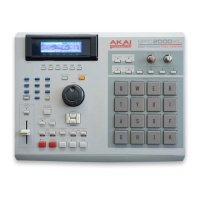Chapter 7: Creating and Editing Programs
Page 122
Copying the Note Parameter
The various settings you make on the parameter screen effect the note number. When a compli-
cated edit is made on a note and you want to use this edit on another note, you can copy the note
parameters to another note.
To open the Copy Note Parameters window, select the Note: field and press OPEN WINDOW.
........................
......................................................................................................
.........................................................................................................
............................
CLOSE
Copy Note ParametersCopy Note Parameters
Prog: 1-NewPgm-A
Note:60/C05-OFF
Prog: 1-NewPgm-A
Note:60/C05-OFF
.....................................................................................
COPY
In the upper part of the window, use the DATA wheel to select the program and the note number
of the sound you want to copy.
In the lower part of the window, use the DATA wheel to select the program and the note number
that you want to copy to.
Copy the note parameters by pressing DO IT [F5].
Setting the Envelope
This edits the envelope of the sounds assigned to each note.
The envelope has three parameters. Select the parameter that you want to edit with the CURSOR
keys and set the number with the DATA wheel.
...............................................................................................
Pgm: 1 Note:60/C05-OFF
Tune:-120
Voice
Overlap:
POLY
<Filter>
Freq:100
Reson: 0Reson: 0
PLAY
PARAMS AUTODRUM PURGE
..................
..................
..........................
ASSIGN
<Envelope>
Attack: Attack: 0
Decay:100
Dcy md:END
•
Attack:
This sets the attack time of the envelope. This is usually set to 0 for drum sound sources.
The higher the value, the slower it sounds.
•
Decay:
This sets the decay time of the envelope. The larger the value the milder the sound decays.
•
Dcy md:
This sets the type of decay.
END The decay ends at the end of the sample. The starting point of the
decay is determined by the settings in the Decay: field. This is
convenient in smoothly fading out the end of a sound.
Also, when a sample is looped, the sample will decay according to the
settings in the Decay: field after note off. (Here, the settings in the
Voice overlap: field is overridden by NOTE OFF. See page
126)
START The decay starts after the attack time.

